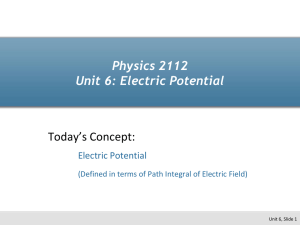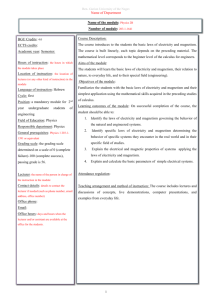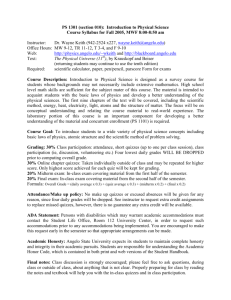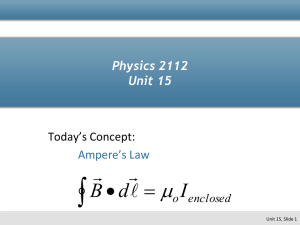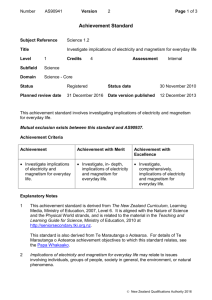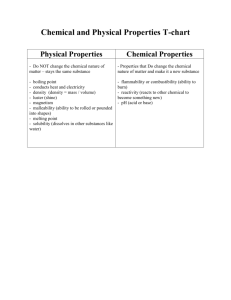Document
advertisement
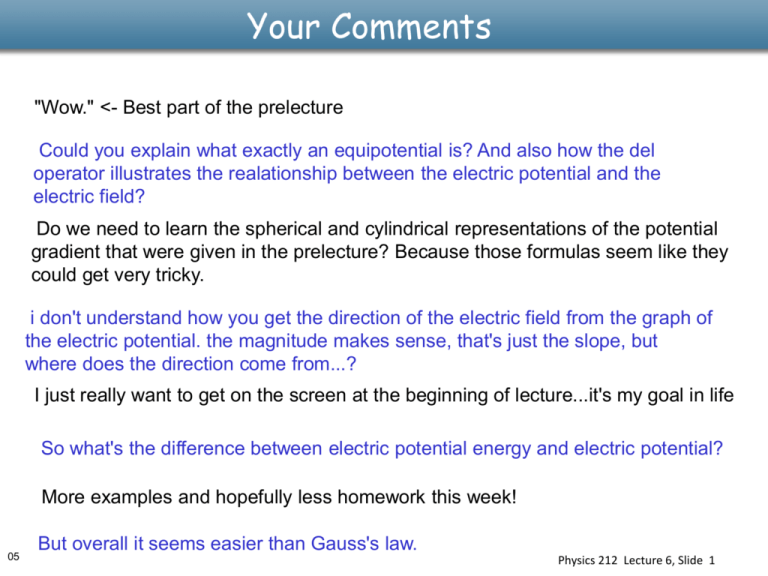
Your Comments "Wow." <- Best part of the prelecture Could you explain what exactly an equipotential is? And also how the del operator illustrates the realationship between the electric potential and the electric field? Do we need to learn the spherical and cylindrical representations of the potential gradient that were given in the prelecture? Because those formulas seem like they could get very tricky. i don't understand how you get the direction of the electric field from the graph of the electric potential. the magnitude makes sense, that's just the slope, but where does the direction come from...? I just really want to get on the screen at the beginning of lecture...it's my goal in life So what's the difference between electric potential energy and electric potential? More examples and hopefully less homework this week! 05 But overall it seems easier than Gauss's law. Physics 212 Lecture 6, Slide 1 Physics 212 Lecture 6 Today’s Concept: Electric Potential (Defined in terms of Path Integral of Electric Field) Electricity & Magnetism Lecture 6, Slide 2 Big Idea Last time we defined the electric potential energy of charge q in an electric field: b F dl qE dl b U ab a a The only mention of the particle was through its charge q. We can obtain a new quantity, the electric potential, which is a PROPERTY OF THE SPACE, as the potential energy per unit charge. Vab b U ab E dl q a Note the similarity to the definition of another quantity which is also a PROPERTY OF THE SPACE, the electric field. F E q Electricity & Magnetism Lecture 6, Slide 3 Electric Potential is like Height (E points down hill for positive charge) While I understand the logic of the math here, I'm having some trouble understanding electric potential intuitively. Could you help explain what exactly the value shows us? Physics 212 Lecture 6, Slide 4 Electric Potential from E field Consider the three points A, B, and C located in a region of constant electric field as shown. D x What is the sign of VAC VC VA ? A) VAC < 0 B) VAC 0 C) VAC > 0 E points down hill E dl C Remember the definition: VAC A Choose a path (any will do!) C E dl E dl D VAC A D 0 E dl Ex < 0 C VAC D Electricity & Magnetism Lecture 6, Slide 5 CheckPoint 2 If the electric field is zero in a region of space, what does that tell you about the electric potential in that region? A) A) B) B) C) C) D) D) The electric potential is zero everywhere in this region. The electric potential is zero at at least one point in this region. The electric potential is constant everywhere in this region. There is not enough information given to distingush which of the above answers is correct. Remember the definition E dl B VAB A E0 VAB 0 V is constant! Electricity & Magnetism Lecture 6, Slide 6 E from V If we can get the potential by integrating the electric field: E dl b Vab a We should be able to get the electric field by differentiating the potential? E V In Cartesian coordinates: Ex V dx Ey V dy V Ez dz Electricity & Magnetism Lecture 6, Slide 7 CheckPoint 1a At which point is the magnitude of the electric field greatest? “A) The The higher the potential the higher the electric field at that point “ “B) The slope of the line is the steepest at point B.” “C) C has the greatest slope “ How do we get E from V? E V V Ex dx Look at slopes! Electricity & Magnetism Lecture 6, Slide 8 CheckPoint 1b A B C D At which point is the electric field pointing in the negative x direction? “B) Negative slope of the line “ “C) There is a positive slope. “ How do we get E from V? E V V Ex dx Look at slopes! Electricity & Magnetism Lecture 6, Slide 9 Equipotentials Equipotentials are the locus of points having the same potential. Equipotentials produced by a point charge Equipotentials are ALWAYS perpendicular to the electric field lines. The SPACING of the equipotentials indicates The STRENGTH of the electric field. Electricity & Magnetism Lecture 6, Slide 10 CheckPoint 3a A B C D At which point is the magnitude of the electric field the smallest? “The electric field lines are the least dense at D “ Electricity & Magnetism Lecture 6, Slide 11 CheckPoint 3b A B C D Compare the work needed to move a NEGATIVE charge from A to B, with that required to move it from C to D A) More work from A to B A) B) B) More work from C to D C) D) C) Same D) Can not determine w/o performing calculation Less than ½ got this correct! Electricity & Magnetism Lecture 6, Slide 12 Hint What are these? A B C D ELECTRIC FIELD LINES! What are these? EQUIPOTENTIALS! What is the sign of WAC work done by E field to move negative charge from A to C ? A) WAC < 0 B) WAC 0 A and C are on the same equipotential C) WAC > 0 WAC 0 Equipotentials are perpendicular to the E field: No work is done along an equipotential Electricity & Magnetism Lecture 6, Slide 13 CheckPoint 3b Again? A B C D Compare the work needed to move a NEGATIVE charge from A to B, with that required to move it from C to D A) B) A) More work from A to B C) B) More work from C to D D) C) Same D) Can not determine w/o performing calculation A and C are on the same equipotential B and D are on the same equipotential Therefore the potential difference between A and B is the SAME as the potential between C Electricity & Magnetism Lecture 6, Slide 14 and D CheckPoint 3c A B C D Compare the work needed to move a NEGATIVE charge from A to B, with that required to move it from A to D A) B) A) More work from A to B C) B) More work from D to D D) C) Same D) Can not determine w/o performing calculation Electricity & Magnetism Lecture 6, Slide 15 Calculation for Potential cross-section a4 a3 +Q a2 a1 +q Point charge q at center of concentric conducting spherical shells of radii a1, a2, a3, and a4. The inner shell is uncharged, but the outer shell carries charge Q. What is V as a function of r? metal metal Conceptual Analysis: Charges q and Q will create an E field throughout space V (r ) E d r r0 Strategic Analysis: Spherical symmetry: Use Gauss’ Law to calculate E everywhere Integrate E to get V Electricity & Magnetism Lecture 6, Slide 16 Calculation: Quantitative Analysis cross-section a4 a3 r > a4 : What is E(r)? +Q A) 0 a2 a1 +q metal r B) Q 4 0 r 2 1 Q+q D) 4 0 r 2 1 C) 1 Q+q 2 0 r 1 Qq E) 4 r 2 0 metal Why? Gauss’ law: Qenclosed E dA 0 E 4 r 2 E Q+q 0 1 Q+q 4 0 r 2 Electricity & Magnetism Lecture 6, Slide 17 Calculation: Quantitative Analysis cross-section a4 a3 a3 < r < a4 : What is E(r)? +Q 1 a2 a1 A) 0 +q metal B) q 4 0 r 2 1 q D) 4 0 r 2 r 1 q C) 2 0 r 1 Qq E) 4 0 r 2 metal Applying Gauss’ law, what is Qenclosed for red sphere shown? A) q B) q C) 0 How is this possible? q must be induced at r a3 surface 3 q 4 a32 charge at r a4 surface Q + q 4 Q+q 4 a42 Electricity & Magnetism Lecture 6, Slide 18 Calculation: Quantitative Analysis cross-section a4 a3 +Q Continue on in… a2 < r < a3 : a2 a1 a1 < r < a2 : +q metal E r r < a1 : 1 q 4 0 r 2 E 0 E 1 q 4 0 r 2 metal To find V: 1) Choose r0 such that V(r0) 0 (usual: r0 infinity) 2) Integrate! 1 Q+q V r > a4 : 4 0 r a3 < r < a4 : A) V 0 B) V C) V Q+q 4 0 a4 1 Q+q 4 0 a3 1 Electricity & Magnetism Lecture 6, Slide 19 Calculation: Quantitative Analysis cross-section a4 a3 r > a4 : +Q V Q+q 4 0 r 1 a3 < r < a4 : V 1 Q + q a2 a1 4 0 a4 +q metal metal a2 < r < a3 : a1 < r < a2 : V (r ) V ( a4 ) + 0 + V (a3 r ) V (r ) Q+q q 1 1 +0+ 4 0 a4 4 0 r a3 V (r ) 1 Q+q q q + 4 0 a4 a2 a3 V (r ) 1 Q+q q q + 4 0 a4 r a3 1 Q+q q q q q V ( r ) + + 0 < r < a1 : 4 0 a4 a2 a3 r a1 Electricity & Magnetism Lecture 6, Slide 20
